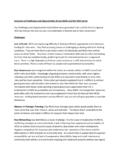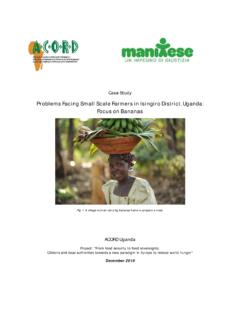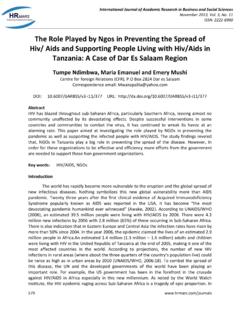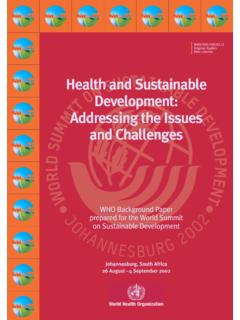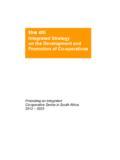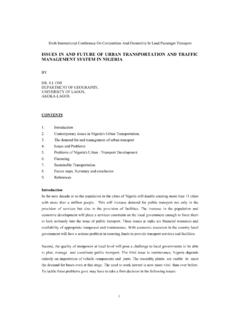Transcription of Strategic framework 2010-2019 - Food and …
1 C 2009/3 August 2009 This document is printed in limited numbers to minimize the environmental impact of FAO's processes and contribute to climate neutrality. Delegates and observers are kindly requested to bring their copies to meetings and to avoid asking for additional copies. Most FAO meeting documents are available on the Internet at W/K5864/e E CONFERENCE Rome, 18 23 November 2009 Strategic framework 2010-2019 TABLE OF CONTENTS Table of contents 1 Foreword 1 I. The challenges facing food, agriculture and rural development 3 II. Vision for FAO and Global Goals of Members 14 III. The results-based regime in the Organization 16 IV.
2 Strategic and Functional Objectives 18 V. Core Functions 30 ANNEX 1 32 ANNEX 2 33 List of Acronyms 34 FOREWORD The first long-term Strategic framework in FAO s history, covering the 2000-15 period, was adopted by the FAO Conference in November 1999, after an extensive process of internal and external consultations. However, the report of the Independent External Evaluation of FAO (IEE) issued in 2007 unequivocally stated that this Strategic framework : has not played the role for which it was intended . Hence, the IEE called for a renewed effort to formulate a Strategic framework for the Organization, which would stand more effectively at the apex of a revitalised family of planning documents, with the complementary Medium Term Plan and biennial Programme of Work and Budget, all being firmly based on Results-based Management (RBM) principles. This call was echoed in the Immediate Plan of Action for FAO s Renewal (IPA) endorsed by the 35th (Special) Session of the Conference in November 2008.
3 Work on the new Strategic framework is a cardinal feature of the IPA and has further engaged both Members and Secretariat during the year 2009, building on the encouraging signs of inter-governmental agreement on some of its key features at the latter Conference. The IEE also expected the Strategic framework : to be aspirational, but .. grounded in pragmatism and rooted in reality . As usual, any forward-looking document of such nature must start with a thorough assessment of trends and challenges (embodying both risks and opportunities) facing Members in the areas of FAO s mandate. This is the purpose of Section I, which also provides a fitting background to the already endorsed Vision for the Organization and the three Global Goals of Members that are recalled in Section II. So as to confirm its overarching and lasting character, the long-term Strategic framework embraces also the enhanced results-based regime to which both Members and management committed to via the IPA, as summarised in Section III.
4 The document then presents the Strategic and Functional Objectives which are to constitute the major conceptual building blocks of the Organization s total package of activities. These are highlighted in Section IV in abbreviated form, with more detailed articulation in the Medium Term Plan. In view of their potential interest in giving a more concrete feel of anticipated impact, the underlying Organizational Results applying to the initial 2010-13 period have been listed. These high-level Objectives have been patiently honed through several rounds of intergovernmental consultations, and equally intense internal discussions within the Secretariat during 2009. They should convey the attention paid to ensuring an appropriate mix of those taking a primarily sectoral approach with those of a more multi-disciplinary nature. They necessarily reflect a fair measure of compromise among the many different aspirations prevailing in the Membership, especially at such a complex and critical juncture in the evolution of the food and agriculture sector, both globally and in individual regions and countries, when more than 1 billion people are going hungry.
5 Finally, the concluding Section V briefly describes the eight core functions singled out in the IPA, while the main Strategic choices and orientations which their application involves are elaborated in the Medium Term Plan. The Strategic framework is in the first instance a document for Governing Bodies, and it is submitted for approval. It will become a valuable source of basic information and reference in order to meet the needs of broader audiences, including partners of FAO and constituents world-wide. More importantly, it provides the broad principles and the specific guidance on the substance of future programmes of work of the Organization. Jacques Diouf Director-General C 2009/3 3I. The challenges facing food, agriculture and rural development Trends, risks and opportunities 1. Fundamental trends will affect food and agriculture at global, national and local levels in the coming decade.
6 Their impacts will generally be felt most strongly in the developing countries, especially as their ability to cope with challenges is more limited. In the shorter term, impact will be compounded by the unfolding global financial and economic crisis. 2. The main challenges facing food, agriculture and rural development are the large and increasing number of undernourished in the world, the prospect of rising inequality and problems of access to food by the most vulnerable populations, and the increased scarcity of natural resources worsened by climate change. Other important concerns include: a) further, though slower population growth for the world as a whole, but continued high population growth in developing countries, particularly in LDCs; b) rapidly ageing populations in developed and relatively advanced developing countries, and dynamic urbanisation in all developing regions.
7 However, continued predominance of youth is still likely in rural areas of sub-Saharan Africa and South Asia, particularly among the poor; c) shifts in food production and consumption patterns, including a growing double burden of malnutrition, the co-existence of undernourishment and over-nutrition; d) increasing demands for food due to higher life expectancy and a better nutritional status; but at the same time, stagnating yields of major cereals, especially wheat and rice, and limited growth potential of capture fisheries; e) continuing challenges associated with international trade, such as for example, barriers to market access and trade distorting domestic subsidies, which affect both the opportunities and terms of trade for developed and developing countries; f) the greater importance of, and concerns about food safety and biosecurity issues, including transboundary pests and diseases; g) the need to implement adequate policies in the field of agriculture and food security at national level, policies which should aim at improving productivity in a sustainable manner; h) considerable pressures on natural resources such as land, water, forest, aquatic resources and biodiversity, which could also fuel potential conflicts; i) climate change and consequent increases in the severity and frequency of weather-related impacts on food production and food security, with more frequent and severe occurrence of emergencies and disasters.
8 J) continuing gender and social inequalities in access to productive resources and services, particularly by women, young and indigenous people in rural areas, intensifying their vulnerability to food insecurity and poverty; k) demands on agriculture to provide not only food and feed, but also commodities for energy and other purposes; l) the interlinkage between energy and agricultural prices and the potential impact that future increases in crude oil prices could have on agriculture prices; and m) the importance of good governance at all levels. 3. There are several opportunities to help address these concerns: a) continued evolution of the state's principal role of providing policy and regulatory frameworks conducive to sustainable development; C 2009/3 4 b) growing number of countries in the middle-income group, and increased role of regional and subregional groupings; c) the growing mobility of capital and labour both across borders and within countries; d) global governance mechanisms to address issues common to all countries, such as food insecurity, biodiversity loss (in particular the erosion of genetic resources for food and agriculture), climate change, deforestation, declining fish stocks, land and water degradation, and disease emergence.
9 E) with respect to international trade, continued efforts to achieve significant improvements to market access, reduce trade-distorting domestic support, reduce or eliminate export subsidies, for the benefit of developed and developing countries, through the successful conclusion of the WTO Doha Development Round; f) industrialisation of the food sector, with rapid changes in the organisation and structure of food, markets and services, including growing importance of the modern retail sector, coordination in value chains, specialised procurement practices, product certification and labelling, and contracting; g) a broadening base of governance to give full recognition to the roles and interests of the private sector, NGOs, regional economic organizations, regional development banks and other agencies; h) increased awareness of the general public regarding environmental, health and development dimensions of food production, trade and consumption systems, prompting governments, civil society and the private sector to act in making food supply chains more environmentally friendly, supportive of human health, and pro-poor; i) the opportunities offered by scientific and technological developments to address nutrition, health and environment problems, coupled with the rapid spread of affordable information and communication technologies, supporting global sharing of information and knowledge, and increasing smallholder market access and know-how; j) steady increase in payment for environmental services in developing countries ( REDD for forestry); k) a new momentum after decades of neglect to re-invest in agriculture.
10 L) evolving financial and institutional environments, particularly amongst humanitarian actors; and m) the evolving role and performance of the UN system in a context of widespread reforms, and the impact of the Paris Declaration on aid harmonisation, alignment and predictability. 4. Furthermore, two main external forces will have a significant bearing on FAO's future work: a) increased vulnerability on a global scale to various forms of shocks: abrupt changes in food prices, movements of people in search of better lives, shifting of climate patterns affecting wide regions, concentration of food production in vulnerable areas; and; b) complex, protracted and recurrent crises affecting agricultural livelihoods, food security and the resilience and coping capacity of rural populations which will continue to affect tens of millions of persons globally - in addition to those people affected by sudden and slow onset of natural disasters.










